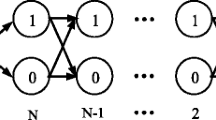Abstract
In this paper, we studied the wireless sensor network coverage and connectivity problem. Considering the artificial bee colony algorithm existed slow convergence, easily falling into the most superior faults, then used the free search algorithm pheromone sensitivity model instead of the traditional roulette wheel selection model. We also proposed a wireless sensor network coverage and connectivity based on improved artificial bee colony algorithm. Analytical proofs and simulation experiments show that compared the random distribution of nodes, genetic algorithms with the proposed algorithm, from the coverage and the number of nodes perceived relationship, the number of nodes connectivity rate and perceived relationship, covering connectivity efficiency, the number of nodes in the network lifetime and perceived relationship, achieving the same coverage and connectivity required time-consuming aspects of WSNs coverage and connectivity issues related to study, the proposed algorithm has the higher of the coverage and connectivity, and reduce data redundancy and network traffic, improve network efficiency.






Similar content being viewed by others
References
Miorandi, D., Sicari, S., De Pellegrini, F., et al. (2012). Internet of things: Vision, applications and research challenges. Ad Hoc Networks, 10(7), 1497–1516.
Zhang, Z., Yu, X., Wu, P., et al. (2015). Survey on water-saving agricultural internet of things based on wireless sensor network. International Journal of Control and Automation, 8(4), 229–240.
Zhu, C., Zheng, C., Shu, L., et al. (2012). A survey on coverage and connectivity issues in wireless sensor networks. Journal of Network and Computer Applications, 35(2), 619–632.
Liang, J., Liu, M., & Kui, X. (2014). A survey of coverage problems in wireless sensor networks. Sensors & Transducers, 163(1), 240–248.
Misra, S., Kumar, M. P., & Obaidat, M. S. (2011). Connectivity preserving localized coverage algorithm for area monitoring using wireless sensor networks. Computer Communications, 34(12), 1484–1496.
Xu, N., Huang, A., Hou, T. W., et al. (2012). Coverage and connectivity guaranteed topology control algorithm for cluster-based wireless sensor networks. Wireless Communications and Mobile Computing, 12(1), 23–32.
Lee, J. W., Choi, B. S., & Lee, J. J. (2011). Energy-efficient coverage of wireless sensor networks using ant colony optimization with three types of pheromones. IEEE Transactions on Industrial Informatics, 7(3), 419–427.
He, S., Chen, J., & Sun, Y. (2012). Coverage and connectivity in duty-cycled wireless sensor networks for event monitoring. IEEE Transactions on Parallel and Distributed Systems, 23(3), 475–482.
Razafindralambo, T., & Simplot-Ryl, D. (2011). Connectivity preservation and coverage schemes for wireless sensor networks. IEEE Transactions on Automatic Control, 56(10), 2418–2428.
Liu, Y., Suo, L., Sun, D., et al. (2013). A virtual square grid-based coverage algorithm of redundant node for wireless sensor network. Journal of Network and Computer Applications, 36(2), 811–817.
Karaboga, D., Gorkemli, B., Ozturk, C., et al. (2014). A comprehensive survey: Artificial bee colony (ABC) algorithm and applications. Artificial Intelligence Review, 42(1), 21–57.
Akay, B., & Karaboga, D. (2012). A modified artificial bee colony algorithm for real-parameter optimization. Information Sciences, 192, 120–142.
Yue, Y., Li, J., Fan, H., et al. (2016). Optimization-based artificial bee colony algorithm for data collection in large-scale mobile wireless sensor networks. Journal of Sensors, 2016, 7057490.
Akay, B., & Karaboga, D. (2012). Artificial bee colony algorithm for large-scale problems and engineering design optimization. Journal of Intelligent Manufacturing, 23(4), 1001–1014.
Eslami, A., Nekoui, M., Pishro-Nik, H., et al. (2013). Results on finite wireless sensor networks: Connectivity and coverage. ACM Transactions on Sensor Networks (TOSN), 9(4), 51.
Castaño, F., Rossi, A., Sevaux, M., et al. (2014). A column generation approach to extend lifetime in wireless sensor networks with coverage and connectivity constraints. Computers & Operations Research, 52, 220–230.
Chen, C. P., Mukhopadhyay, S. C., Chuang, C. L., et al. (2015). Efficient coverage and connectivity preservation with load balance for wireless sensor networks. IEEE Sensors Journal, 15(1), 48–62.
Akhlaq, M., Sheltami, T. R., & Shakshuki, E. M. (2014). C3: An energy-efficient protocol for coverage, connectivity and communication in WSNs. Personal and Ubiquitous Computing, 18(5), 1117–1133.
Sengupta, S., Das, S., Nasir, M., et al. (2012). An evolutionary multiobjective sleep-scheduling scheme for differentiated coverage in wireless sensor networks. IEEE Transactions on Systems, Man, and Cybernetics, Part C (Applications and Reviews), 42(6), 1093–1102.
Gupta, S. K., Kuila, P., Jana, P. K. (2015). Genetic algorithm approach for k-coverage and m-connected node placement in target based wireless sensor networks. Computers & Electrical Engineering, 56(11), 544–556.
Acknowledgements
The authors would like to thank the anonymous reviewers for helpful comments which helped them improve the technical quality of the paper. This study was supported by the National Nature Science Foundation of China under Grant 61201247, 11705122 and 61801319, in part by the Opening Project of Hubei Province Education Department Scientic Research Plan Key Project under Grant D20182603, in part by the Hubei University of Arts and Sciences Talent Introduction Project, in part by the Project of Sichuan Science and Technology Department Grant 2017JY0338 and 2019YJ0477, the Key Laboratory Project of Artificial Intelligence in Sichuan Province Grant 2017RYY02, the Sichuan Institute of Technology Talent Introduction Project Grant 2017RCL53, in part by the Opening Project of the Key Laboratory of Higher Education of Sichuan Province for Enterprise Informationalization and Internet of Things under Grant 2018WZY01 and the Project of Sichuan Provincial Academician (Expert) workstation of Sichuan University of Science and Engineering under Grant 2018YSGZZ04, the Opening Project of Material Corrosion and Protection Key Laboratory of Sichuan Province (2017CL09), the Xiangyang Research and Development Project.
Author information
Authors and Affiliations
Corresponding author
Additional information
Publisher's Note
Springer Nature remains neutral with regard to jurisdictional claims in published maps and institutional affiliations.
Rights and permissions
About this article
Cite this article
Yue, Y., Cao, L. & Luo, Z. Hybrid Artificial Bee Colony Algorithm for Improving the Coverage and Connectivity of Wireless Sensor Networks. Wireless Pers Commun 108, 1719–1732 (2019). https://doi.org/10.1007/s11277-019-06492-x
Published:
Issue Date:
DOI: https://doi.org/10.1007/s11277-019-06492-x




